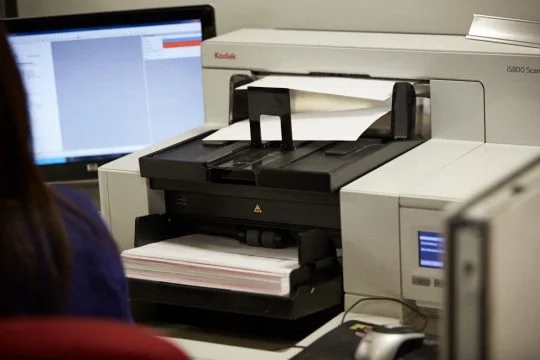Datamation has worked with benefit funds, including multiemployer funds subject to Taft-Hartley compliance, for over 25 years. And in those 25 years, we’ve learned that no two funds have the same set of retention rules for their documents.
If your fund office doesn’t have an official record retention policy, or maybe a loose set of guidelines that aren’t exactly enforced, rest assured that you are not alone. That’s why we recently partnered with benefit fund administration software company, ISSI Systems, on a webinar reviewing retention rules for fund offices, how you can start on your own retention policy, and best practices on how to stick to those schedules.
We’ve embedded the replay below, or you can continue on with the blog post.
How Long Do I Need to Keep Fund Office Records?
Whenever we start working with a new fund office client, we often hear, “How long do I need to keep these records?” And the answer? It really depends on the record!
In general, all plan-related records should be kept for at least seven years, but many need to be maintained permanently, and others until the participant in question is paid their benefit under the plan.
We’ll list specific types of documents below. We gathered all this information via the International Foundation of Employee Benefit Plans.
Fund Documents Recommended to Keep Permanently
These records should be kept permanently:
- Minutes of board meetings
- Contribution reports*
- Participant files
- Trust agreement and amendments
- Investment guidelines
- Form 5500
- Form 990
- Application for IRS qualifications
- Summary plan descriptions
- Documents evidencing trustee appointments
- Fiduciary liability insurance
- Reports from independent auditors
- Actuarial reports
- Jurisdiction
*Parts of contribution reports are sometimes classified as accounting files and thus have a retention of seven years. See next section for more.
Fund Documents Recommended to Keep Six Years + Current Year
Most of the records listed here are your financial documents:
- Collective bargaining agreements
- Pension payments
- Bank statements
- Canceled checks
- W-2 forms
- 1099 forms
- Expired insurance policies
- Fidelity bond
- Actuarial reports
The recommendation of six years plus the current year is generally simplified into seven years in retention schedules.
Fund Documents Recommended to Keep Four Years
There’s only one record type that currently has a four-year retention guideline:
- Enrollment cards
Many funds store enrollment cards with participant files. So while you may be able to dispose of them after four years, it’s a lot of manual work to comb through participant files and pull out enrollment cards that have met their retention. We’ll get to solutions for that soon.

Making a Document Retention Schedule for Your Benefit Fund
Now that you’ve read the recommendations for file retention, we want to be clear that this does not mean that you should copy and paste these lists and call it a day. Every fund office has different needs and may have different state or local guidelines. This is just a starting point to your official retention policy.
When it comes to drafting an official document retention policy, you must meet these three criteria:
- The policy must be in writing.
- The policy must be reviewed by your legal counsel.
- The policy must be approved by your board.
All of these are necessary, but the legal counsel piece is key. Every state has different rules about how long documents need to be kept, so you will need to keep those in consideration as you draft your policy.
Determine Your Level of Risk
Additionally, you also need to consider your level of organizational risk. Some fund offices like to keep records longer than federal mandates. Some offices like to keep documentation forever. However, if you keep documents and data longer than their necessary retention, your organization will be liable for that data.
For example, if litigation comes up that requires documentation from your fund, you are required to turn over all necessary data. However, if the data has already met its retention and been purged, you would not be required to produce it.
There are pros and cons to keeping data longer than required, so it’s up to you, your legal counsel, and your board to decide what level of risk is right for your fund office.
It’s also important to stay up to date on any legal changes that may impact your retention policy. Many states seem to be trending to shorter retention periods. So something that may need to kept for seven years now could be shortened in the future.
Here are some additional resources for developing your records retention policy:
- To Purge, or Not to Purge, That Is the Question
- What Needs to Be Addressed in a Records Retention and Destruction Policy?
- The Importance of Retaining and Protecting Employee Benefit Plan Records
Best Practices for Managing Document Retention Schedules
Now that we’ve gone over the foundation for creating a record retention policy, let’s cover some best practices on managing said retention policy.
Digitize Your Multiemployer Fund Office Files
The simplest way to management your documents and their retention schedules is to digitize your files. Digitizing your files opens up the possibility to automate your retention policy. As in, you can set the retention schedule for a document and you don’t need to think about it again until it reaches the end of its lifecycle.
You’ll need to look into a document management system to accomplish automated retention schedules. We recommend the PaperVision or ImageSilo systems as we have direct integrations with leading benefit fund software. However, nearly any leading document management system will have this capability.
Remember the enrollment cards from before? With a document management system you can flag those documents for a four year retention. When their retention has been met, you will get an alert from the system. That’s a lot more efficient than looking through individual file folders!

Scanning Your Paper Records
When it comes to the actual conversion of paper records, you can either purchase scanners and do this yourself, or you can outsource your backfile scanning to a document scanning company.
Keeping the scanning in-house allows greater control over the project, but it is also a time-consuming process. Also, once the backfile scanning is complete, you may have equipment that isn’t useful going forward. Read our article about in-house vs outsourced scanning for more.
In general, our clients opt to handle the day forward scanning themselves, but let us manage their backfile paper and microfilm scanning.
Complete a File Assessment
Whether you decide to digitize your files or not, it’s a good idea to get a full understanding of the documents that you have.
First, gather your files. They may be on-site in filing cabinets and boxes, off-site in a warehouse, or they could already be scanned and sitting in folders on your server.
Second, look through these documents and classify them (e.g. contribution report, board minutes, etc.).
Third, decide on the record’s disposition. This generally falls into the buckets of capture/scan, shred/destroy, and warehouse/store. Should we scan the record? Should we destroy the record? Do you want to scan it and then store it off-site anyway? There isn’t just one choice, so make sure that you have the right decision makers involved with these conversations.
Please note that while fund offices can do this themselves, a good document management company (like us!) will be able to do this for you or give you the tools to simplify your own assessment.

Other Benefits of Digitizing Your Multiemployer Fund Office Files
Converting your documents into electronic files doesn’t just make retention easier. There are plenty of other benefits, such as:
- Immediately gain more space in your office
- Access documents from anywhere, whether working remotely or traveling
- Superior privacy and compliance, especially for HIPAA
- Digital backups for quick disaster recovery
- Simplified auditing process: auditors can only see the files you allow them to see and can access files remotely
- File integration with other digital systems, like ISSI
To learn more about the ISSI integration, please watch the video embedded higher up on this page. There is a demo at the 18 minute mark.
Your Next Steps
We’ve covered a lot in this article, so once again, here are steps you should take:
- Review or create document retention schedules using the resources here as a starting point
- Stay up to date on legal changes both at the federal and state level
- Confirm retention policy with legal counsel and board
- Find and assess your fund’s records
- Consider digitizing your files to streamline retention schedules and other processes
If at any point you have questions about this process or want some more insight, don’t hesitate to contact us or call (630) 321-0601. If you have comments on this article, please find us on LinkedIn or Twitter!